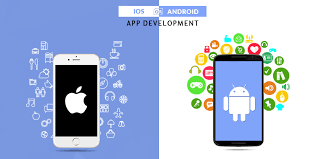Introduction
In the fast-paced landscape of technological evolution, mobile playboi carti merch applications stand as the cornerstone of our interconnected world. As smartphones continue to permeate every aspect of our daily lives, the demand for innovative and user-centric apps on both iPhone and Android platforms is reaching unprecedented heights. For aspiring developers and visionary entrepreneurs, this exhaustive guide aims to unravel the complexities involved in the holistic process of developing applications that seamlessly resonate with the distinctive ecosystems of iOS and Android.
Understanding the Platforms
To embark on a successful journey into app development, one must first grasp the nuances that differentiate the iOS and Android platforms. Beyond the apparent differences in design aesthetics lie fundamental distinctions in programming languages, development environments, and distribution channels. While Swift and Objective-C take precedence for iOS, Java and Kotlin emerge as the stalwarts for Android development. This foundational understanding sets the stage for a nuanced exploration of the dynamic realm of mobile app creation.
- Define Your App’s Purpose and Target Audience
The inception of any successful app begins with a crystal-clear definition of its purpose and a profound understanding of the target audience. What problem does your app aim to solve? Who are your potential users? These questions serve as the guiding stars, shaping the features, design, and functionality of your app. A thorough market analysis, delving into potential competitors and unique selling propositions, lays the groundwork for a compelling and market-ready application.
- Sketch Your App’s Design and User Experience
Transitioning from ideation to implementation, the next step involves sketching the design and user experience (UX) of your app. Wireframes and conceptual sketches serve as the blueprints, mapping out the user flow, navigation, and overall aesthetics. Adhering to the design principles laid out by Apple’s Human Interface Guidelines for iOS and Google’s Material Design for Android ensures a cohesive and user-friendly experience, regardless of the chosen platform.
- Choose the Right Development Tools and Environment
The selection of appropriate development tools and environments is xxxtentacion shop pivotal for ensuring efficiency and productivity throughout the development lifecycle. Xcode, the integrated development environment (IDE) from Apple, takes center stage for iOS development, while Android Studio emerges as the preferred IDE for Android. A meticulously configured development environment, equipped with the necessary Software Development Kits (SDKs), lays the groundwork for a seamless and effective development process.
- Learn the Programming Languages
Proficiency in the programming languages specific to each platform is the linchpin of successful app development. Swift and Objective-C for iOS, Java or Kotlin for Android – investing time in mastering these languages forms the backbone of your coding endeavors. Harness online resources, tutorials, and official documentation provided by Apple and Google to cultivate a deep understanding of the languages relevant to your chosen platform.
- Start Coding
With a solid understanding of your app’s design and functionality, the coding phase commences. Breaking down the development process into manageable tasks and utilizing version control systems like Git facilitates collaboration and ensures the tracking of changes. Regular testing of the code at various stages is imperative for the early detection and rectification of bugs.
- Implement Platform-Specific Features
Both iOS and Android boast unique features and capabilities that can kanye west merch enhance your app’s functionality and user experience. From 3D Touch and Face ID on iOS to deep integration with Google services and customizable widgets on Android, leveraging these platform-specific attributes is crucial. A balanced integration approach that maximizes platform strengths while ensuring a cohesive user experience across platforms is paramount.
- Ensure Cross-Platform Compatibility
While capitalizing on platform-specific features is essential, achieving cross-platform compatibility is equally critical. Rigorous testing across a spectrum of devices and screen sizes guarantees a consistent and enjoyable user experience, irrespective of whether the app is accessed on an iPhone, iPad, or a myriad of Android devices.
- Test, Test, Test
The testing phase is the crucible where your app’s mettle is tested and refined. Conducting thorough manual and automated tests scrutinizes usability, performance, and security aspects. Leveraging testing frameworks such as XCTest for iOS and JUnit for Android enhances the efficiency of this phase, enabling developers to identify and rectify potential issues before they reach end-users.
- Optimize for Performance
Performance optimization is a continual endeavor aimed at delivering a seamless and responsive user experience. Prioritize factors such as app startup time, responsiveness to user interactions, and efficient memory usage. Profiling tools provided by Apple and Google assist in identifying and addressing performance bottlenecks, ensuring your app operates at peak efficiency.
- Secure Your App
In an era where data security is paramount, integrating robust security measures into your app is non-negotiable. Implement secure coding practices, employ encryption for sensitive data, and stay abreast of the latest security threats and best practices. Regularly update your app’s security protocols to fortify its resilience against emerging threats.
- Prepare for App Store and Google Play Submission
The culmination of your development journey involves preparing your app for submission to the App Store and Google Play. Ensuring compliance with the guidelines and policies of each platform is imperative. Curate captivating app store listings that feature engaging graphics, clear descriptions, and compelling promotional materials. Adhering to the submission processes meticulously minimizes potential delays and maximizes the visibility of your app.
- Monitor and Update Your App
Post-launch, the journey enters a new phase of evolution. Vigilantly monitoring user feedback, reviews, and analytics provides invaluable insights into user behavior. Regularly updating your app, introducing new features, addressing user concerns, and staying compatible with the latest operating system versions is vital for the sustained success and relevance of your application.
Conclusion
Embarking on the exhilarating journey of develop iPhone and Android app demands a multifaceted approach, blending creativity, technical acumen, and adaptability. This comprehensive guide, designed as a compass through the vast expanse of mobile app creation, aims to equip developers and entrepreneurs with the knowledge and strategies needed for success. Stay attuned to the dynamic landscape of technology, continue learning, and be receptive to user feedback. With the right mindset and skill set, your app can transcend the realms of imagination and become a tangible manifestation of innovation in the ever-evolving tapestry of mobile technology.

